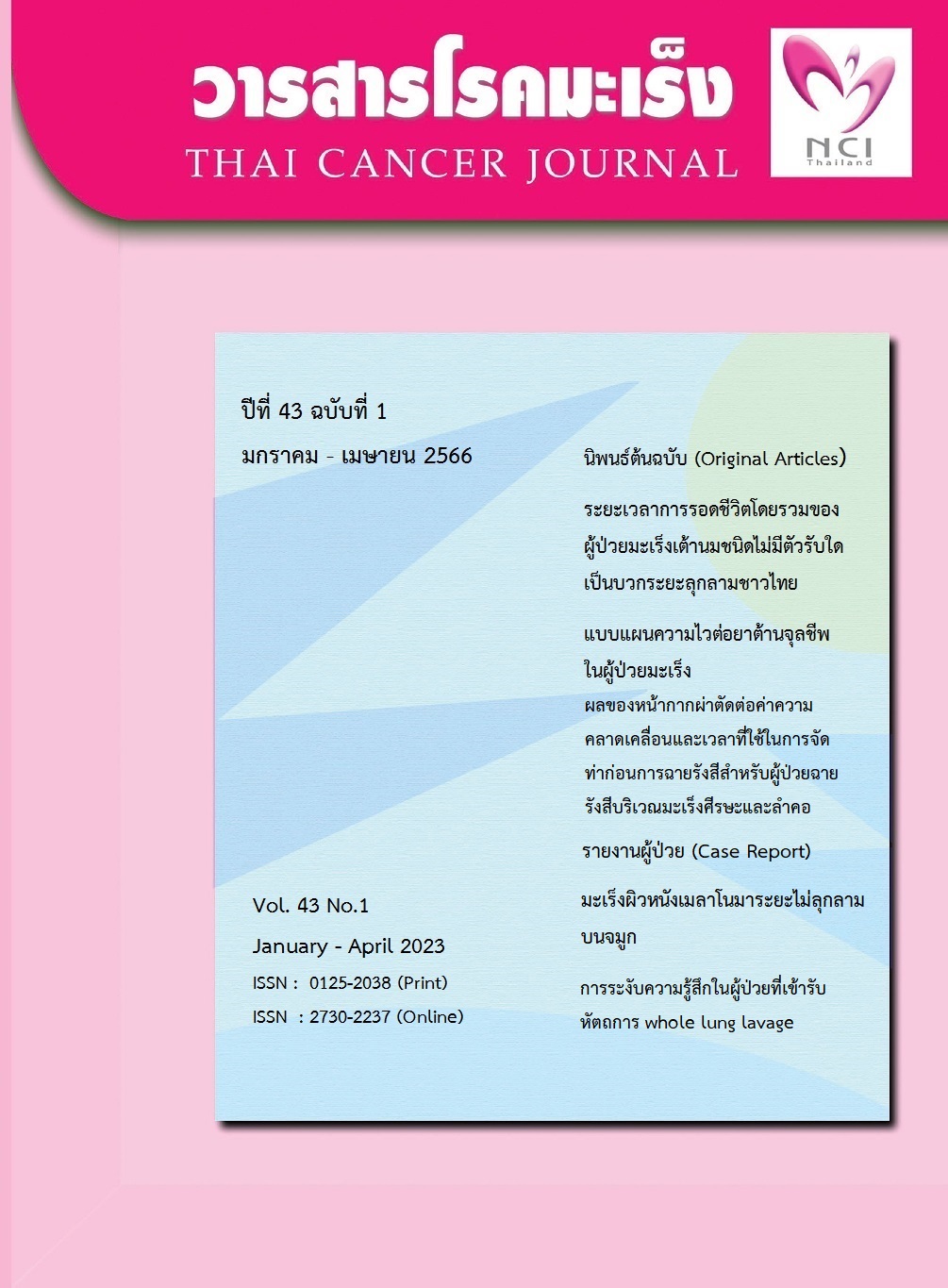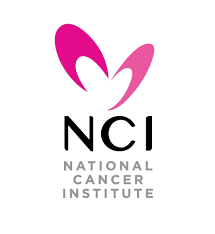Antibiogram in cancer patients
Keywords:
Antibiogram, Antimicrobial resistance, cancerAbstract
Antibiogram is an important data regarding to antimicrobial selection during microbial culture procedure (empirical therapy). This data can be use to monitoring trends of antimicrobial resistance in hospital. The objective of this retrospective study is to monitoring trend of antimicrobial resistance among bacterial pathogens in cancer patients at The National Cancer Institute during 2019 - 2021. Data were analyzed by descriptive statistical method which are 95% Confidence interval , Odds ratio and Chi-square test. The data of culture and sensitivity test in microbiology laboratory which specimen were urine, sputum, pus, body fluid and blood culture found 2,100 isolations. Top 5 of common isolations were E. coli (23%), P. aeruginosa (12%) followed by K. pneumoniae (11%) Enterococcus spp.(7%) and Acinetobacter spp (4%). E. coli were susceptible to carbapenem, TZP and AN mostly 90% and trend of antimicrobial sensitivity to AMC and GM were increase significantly (OR; 1.77, 95%CI; 1.10 - 2.87, P=0.019) and (OR; 2.61 95%CI; 1.59– 4.28, P< 0.001) respectively. P. aeruginosa were susceptible to CT mostly 99% and trend of antimicrobial to IPM were increase significantly (OR; 2.42 95%CI; 1.23 - 4.75, P=0.010). K. pneumoniae were susceptible to AN mostly 90% and trend of antimicrobial resistant significant to CAZ, CTX, CRO, FEP, DOR, IPM, MEM, CIP and SXT were decrease (OR; 0.3 - 0.4, 95%CI; 0.23-0.91, 0.24-0.94, 0.20-0.80, 0.21-0.86, 0.12-0.98, 0.21-1.24,0.21-1.24,0.23-0.89, 0.23 - 0.91 respectively, P<0.05). Enterococcus spp were susceptible to VA mostly 88% trend of antimicrobial to CIP and E were increase significantly (OR; 3.909, 95%CI; 1.20 - 12.76, P= 0.024) and (OR; 4.929, 95%CI; 1.01 - 24.126, P= 0.049) respectively. In 2021 sensitivity trend to P and AMP decrease (OR;0.385, 95%CI; 0.15 – 0.97, P= 0.042) and (OR;0.309, 95%CI; 0.12-0.81, P= 0.017) respectively. Acinetobacter spp. were suscep- tible to CT mostly 95% and trend of antimicrobial sensitivity to DOR in 2020 - 2021 decrease significantly (OR;0.257, 95%CI; 0.07 - 0.89, P= 0.033) and (OR;0.148, 95%CI; 0.04 – 0.60, P= 0.008) respectively.ฤ
References
Resistance in 2019: a systematic analysis. published online. 2022;399: 629-55
Carlota Gudiol, Jordi Carratala. Antibiotic resistance in cancer patients. expert reviews anti-infective Therapy. 2014;12:1003-16
ภาณุมาศ ภูมาศ, วิษณุ ธรรมลิขิตกุล, ภูษิต ประคองสาย, ตวงรัตน์ โพธะ, อาทร ริ้วไพบูลย์, สุพล ลิมวัฒนานนท์. ผลกระทบด้านสุขภาพและเศรษฐศาสตร์จากการติดเชื้อดื้อยาต้านจุลชีพในประเทศไทย. วารสารวิจัยระบบสาธารณสุข 2555;6(3):352-60.
กระทรวงสาธารณสุข. แผนยุทธศาสตร์การจัดการเชื้อดื้อยาต้านจุลชีพในประเทศไทยปี พ.ศ. 2560-2564 .[อินเทอร์เน็ต]. [เข้าถึงเมื่อ 1 สิงหาคม 2565]. เข้าถึงได้จาก: http://dmsic.moph.go.t3.
Clinical and Laboratory Standards Institute. 2014. Analysis and Presentation of Cumulatve Antmicrobial Susceptibility Test Data; Approved Guideline—Fourth Edition. CLSI document M39-A4. Clinical and Laboratory Standards Institute, Wayne, PA
Janet F Hindler, John Stelling. Analysis and Presentation of Cumulative Antibiograms: A New Consensus Guideline from the Clinical and Laboratory Standards Institute. medical microbiology. 2007;44:867-73
Kenneth P. Klinker, Levita K. Hidayat, C. Andrew DeRyke, Daryl D. DePestel, Mary motyl , Karri A. Bauer. Antimicrobial stewardship and antibiograms: importance of moving beyond traditional antibiograms. Therapeutic Advances in infectious Disease. 2021;8:1-9
สถาบันวิจัยวิทยาศาสตร์สาธารณสุข กรมวิทยาศาสตร์การแพทย์ กระทรวงสาธารณสุข. คู่มือการปฏิบัติงานแบคทีเรียและรา สำหรับโรงพยาบาลศูนย์และโรงพยาบาลทั่วไป. พิมพ์ครั้งที่ 3 กรุงเทพมหานคร: บริษัท พรีเมียร์ มาร์เก็ตติ้ง โซลูชั่น จำกัด; 2561
Clinical and Laboratory Standards Institute. Performance standards for antimicrobial susceptibility testing. CLSI guideline M100. 29th ed. Wayne, PA: CLSI, 2019
European Committee on Antimicrobial Susceptibility Testing (ECAST). Breakpoint tables for interpretation of MICS and zone diameters. 2019.
Thermo Scientific. Thermo Scientific Sensititre Susceptibility and Identification System. [อินเทอร์เน็ต].[เข้าถึงเมื่อ 10 สิงหาคม 2565]. เข้าถึงได้จาก:http://tools.thermofisher.com /content/sfs/ brochures/Sensititre%20Brochure_EN.pdf
National Antimicrobial Resistance Surveillance Center. Antimicrobial Resistance 2000- 2020 [อินเทอร์เน็ต].[เข้าถึงเมื่อ 10 สิงหาคม 2565].เข้าถึงได้จาก: http://narst.dmsc.moph.go.th
Wichai Santimaleeworagun, Wandee Samret, Praewdow Preechachuawong, Mattana Sunpurksin, Sarinrat Tobarameekul, Supakit Hussanunt. A comparison between conventional and stratified antibiograms for antibiotic empirical therapy among the most bacterial pathogens. Science, Engineering and Health Studies 2020;14(3):152-59
Vivek Bhat, Sudeep Gupta, Rohini Kelkar, Sanjay Biswas, navin Khattry, Aliasgar Moiyadi, et al. Bacteriological profile and antibiotic susceptibility patterns of clinical isolates in a tertiary care cancer center.india journal of medical and paediatric onco- logy.2016;37(1):20-24
Sevitha Bhat, Shruthi Muthunatarajan, Shaiini Shenoy Mulki, K.Archana Bhat, Himani Kotian. Bacterial Infection among Cancer Patients: Analysis of Isolates and Antibiotic Sensitivity Pattern. Hindawi international Journal of Microbiology. 2021;2021:8883700
Ramadan Eldomany and Neveen A. Abdelaziz.Characterization and antimicrobial susceptibility of gram negative bacteria isolated from cancer patients on chemotherapy in Egypt. iMedPub Journals. 2011;2:2 doi: 10:3823/243
Abdulaziz A. Zorgani, Zuhair Belgasim, Hisham Ziglam, Khalifa Sifaw Ghenghesh. Antimicrobial Susceptibility Profiles of GramNegative Bacilli and Gram-Positive Cocci Isolated from Cancer Patients in Libya. iMedPub Journals. 2012;3:doi 10.3823/253
Brenna M. Roth, Alexandra Laps, Kaunda Yamba, Emily L. Heil, J.Kristie Johnson, Kristin Stafford, et al. Antibiogram Development in the Setting of a High Frequency of Multi-Drug Resistant Organisms at University Teaching Hospital, Lusaka, Zambia. antibiotic. 2021;10: 782
Susette K Var, Rouba Hadi, Nancy M Khardori. Evaluation of regional antibiograms to monitor antimicrobial resistance in hampton roads, Virginia. Annals of Clinical Microbiology and Antimicrobials .2015;14:22
Balaji Veeraraghavan, Mark Ranjan Jesudason, John Antony Jude Prakasah, Shalini Anandan, Rani Diana Sahni, Agila Kumari Pragasam, et al. Antimicrobial Susceptibility Profiles of Gram-Negative BacteriaCausing Infections Collected Across India during 2014–2016: Study for MonitoringAntimicrobial Resistance Trend Report. Indian Journal of Medical Microbiology. 2018;36:32-6
Saad Alhumaid, Abbas Al Mutair, Zainab Al Alawi, Ahmad J. Alzahrani, Mansour Tobaiqy, Ahmed M. Alresasi, et al. Antimicrobial susceptibility of gram-positive and gram-negative bacteria: a 5-year retrospective analysis at a multi-hospital healthcare system in Saudi Arabia. Annals of Clinical Microbiology and Antimicrobials. 2021;20:43
Leo Lui, LC Wong, H Chen, Raymond WH Yung. Antibiogram data from private hospitals in Hong Kong: 6-year retrospective study. Hong Kong Med Journal. 2022;28:140–51
Downloads
Published
Versions
- 2023-06-28 (4)
- 2023-06-20 (3)
- 2023-06-20 (2)
- 2023-04-28 (1)
Issue
Section
License
Copyright (c) 2023 Thailand's National Cancer Institute Foundation

This work is licensed under a Creative Commons Attribution-NonCommercial-NoDerivatives 4.0 International License.
บทความทีตีพิมพ์ในวารสารโรคมะเร็งนี้ถือว่าเป็นลิขสิทธิ์ของมูลนิธิสถาบันมะเร็งแห่งชาติ และผลงานวิชาการหรือวิจัยของคณะผู้เขียน ไม่ใช่ความคิดเห็นของบรรณาธิการหรือผู้จัดทํา






